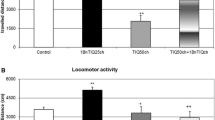Summary
Tritium labelled 1-carboxy-tetrahydroharman was identified in rat brain following i. c. v.-injection of [3H]tryptamine and pyruvic acid. The animals had been treated with the MAO inhibitor pargyline (40 mg/kg) 30 min before i. c. v. injection. Under these conditions, only trace amounts of [3H]indole acetic acid could be detected in the brain. The formation of 1-CTHH was time-dependent. Five minutes following the i. c. v. injection, approximately 0.45% of the administered tryptamine was converted into 1-CTHH and 23% were still unchanged. The amount of the radioactive 1-CTHH increased slightly within 1 h (0.8%; [3H] tryptamine: 6%). Pretreatment of the rats with high doses of pargyline (75 mg/kg; 90 min before i. c. v. injection) prevented the formation of both [3H]1-CTHH and [3H]indole acetic acid (IAA) suggesting that high doses of pargyline inhibit the formation of 1-CTHH. As control for a possible non-enzymatic formation of 1-CTHH, [3H]tryptamine and various concentrations of pyruvic acid were incubated in phosphate buffer at pH 7.4. 1-CTHH was not detected under these conditions. However, the formation of 1-CTHH was observed at high pyruvic acid concentrations (final concentration = 100 mM) and low pH values (< pH4). To support the assumption that the observed condensation of both precursors to 1-CTHH occurred intracellularly, the metabolism of tryptamine was studied. Two minutes after i. c. v. injection of [3H]tryptamine approximately 4% of the injected dose remained unchanged and 10% were metabolized to [3H]IAA. These findings suggest a rapid disappearance of [3H]tryptamine from the cerebrospinal fluid as well as a rapid penetration into the cerebral tissue.
The identification of the 1-CTHH formed after in vivo administration of both precursors was carried out by thin layer chromatography in various solvent systems, methylation yielding the methyl ester derivative and in vitro decarboxylation to harmalan with rat liver homogenate and PLP as co-enzyme.
The present results suggest an alternative pathway for the biosynthesis of β-carbolines in rats.
Similar content being viewed by others
Abbreviations
- BC:
-
β-carboline
- 1-CTHH:
-
1-carboxy-tetrahydroharman, 1,2,3,4-tetrahydro-1-methyl-β-carboline-1-carbolic acid
- 1H-NMR:
-
nuclear magnetic resonance
- IAA:
-
indole acetic acid
- i.c.v.:
-
intracerebroventricular
- i.p.:
-
intraperitoneal
- MAO:
-
monoamine oxidase
- m. p.:
-
melting points
- MS:
-
mass spectroscopy
- p.i.:
-
post injectionem
- PLP:
-
pyridoxal-5-phosphate
- THH:
-
tetrahydroharman
- TLC:
-
thin layer chromatography
- TMS:
-
tetramethylsilane
References
Collins MA, Dahl K, Nijm W, Major LF (1982) Evidence for homologous families of dopamine and serotonin condensation products in CSF from monkeys. Soc Neurosci 8:277
Copeland ES, Campbell JC, Murphy DL (1983) Interaction between cytosolic monoamine oxidase and spinlabelled amphetamine and its modification by clorgyline ad pargyline. Biochem Biophys Acta 743:186–194
DeBoer ThJ, Backer HJ (1956) Diazomethane. Org Syntheses 36:16–19
Fujishima M, Ogata J Oniki H, Onoyama K, Morotomi K, Omae T (1978) Lactate, pyruvate and ATP concentrations of the brain in two models of hypertension in rats. Brain Res 152:189–195
Hahn G, Barwald L, Schales O, Werner H (1935) Synthese von ] Tetrahydroharman(4-Carbolin)-Derivaten unter physiologischen Bedingungen. Justus Liebigs Annal Chem 520:107–123
Herbert RB, Mann J (1982) The biosynthesis of the β-carboline alkaloids, harman and eleagnine. J Chem Soc Perkin Trans I:1523–1525
Honecker H, Rommelspacher H (1978) Tetrahydronorharman (tetrahydro-β-carboline), a physiologically occurring compound of indole metabolism. Naunyn-Schmiedeberg's Arch Pharmacol 305:135–141
Kari J, Peura P, Airaksinen MM (1980) Quantitative gas chromatography mass spectrometric determination of 1,2,3,4-tetrahydro-β-carboline in human plasma and platelets. Biomed Mass Spectrom 7:549–552
Mayanil CSK, Baquer NZ (1982) Clorgyline and deprenyl insensitive monoamine oxidase in rat brain soluble fraction. Biochem Pharmacol 31:3925–3927
Meek JL, Krall AR, Lipton MA (1970) Psychotropic drugs and the metabolism of intracerebrally injected tryptamine, 5-hydroxytryptamine and norepinephrine. J Neurochem 17:1627–1635
Rommelspacher H, Damm H, Strauß S, Schmidt G (1984) Ethanol induces an increase of harman in the brain and urine of rats. Naunyn-Schmiedeberg's Arch Pharmacol 327:107–113
Rommelspacher H, Bruning G, Susilo R, Nick M, Hill R (1985) Pharmacology of harmalan (1-methyl-3,4-dihydro-β-carboline). Eur J Pharmacol 109:363–371
Shoemaker DW, Cummins JT, Bidder TG, Boettger HG, Evans M (1980) Identification of harman in the rat arcuate nucleus. Naunyn-Schmiedeberg's Arch Pharmacol 310:227–230
Späth E, Lederer E (1930) Synthese der Harmala-Alkaloide. Chem Ber 63:120–125
Author information
Authors and Affiliations
Additional information
This study was supported by the Deutsche Forschungsgemeinschaft
Send offprint requests to R. Susilo at the above address
Rights and permissions
About this article
Cite this article
Susilo, R., Rommelspacher, H. Formation of a β-carboline (1,2,3,4-tetrahydro-l-methyl-β-carboline-1-carboxylic acid) following intracerebroventricular injection of tryptamine and pyruvic acid. Naunyn-Schmiedeberg's Arch Pharmacol 335, 70–76 (1987). https://doi.org/10.1007/BF00165039
Received:
Accepted:
Issue Date:
DOI: https://doi.org/10.1007/BF00165039



